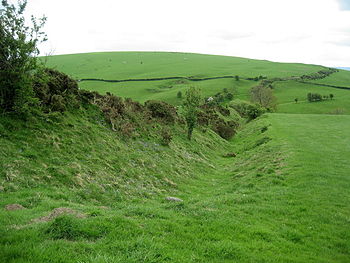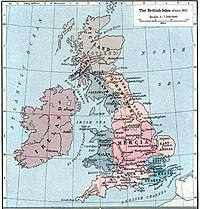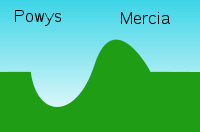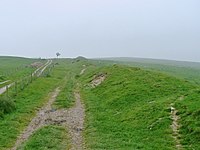Offa's Dyke

Offa's Dyke (Welsh: Clawdd Offa) is a massive linear earthwork running north-south in a line once perhaps 150 miles, roughly followed the boundary between England with Wales, which it was designed during the Dark Ages to mark border. In places, it is up to 65 feet wide (including its flanking ditch) and 8 feet high.
The work is a defensive earthwork, consisting of a classic bank and ditch. The ditch is to the west, showing it to have been built to defend the Mercian side to the east.
The dyke was created in the 8th century to form a delineation between the English kingdom of Mercia and the Welsh kingdom of Powys. It is attributed to King Offa, under whom Mercia reached the pinnacle of its power.
Overview



It is generally accepted that much of the earthwork can be attributed to Offa, King of the Mercians from 757 to 796. Its is dug as a bank and ditch, the displaced soil piled into a bank on the Mercian (eastern) side, to produce a formidable barrier against attack from the west. Where the earthwork encounters hills, it passes to the west of them, constantly providing an open view from Mercia into Wales. The dyke is in form a defensive earthwork, and a political statement of power, as well as a practical boundary marker emplaced after centuries of warfare and shifting boundaries.
Offa was one of the great rulers of the Anglo-Saxon age, though his reign is often overlooked due to a limitation in source material. That he was able to raise a workforce and resources sufficient to construct such an earthwork as Offa's Dyke is testament to his power. It is likely that some form of 'service' system along the lines of corvée was used to construct the Dyke, with people from certain areas being required to build a certain length of the wall. This can be seen as additional to the normal services that had to be offered to kings. A document exists from around this period known as Tribal Hidage, which makes some assessment of how land was distributed in the 8th century. Though there is little evidence to associate the document with the Dyke, it is possible that both the Dyke and the document stem from a common practice.